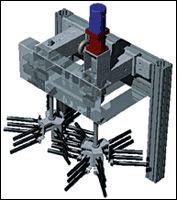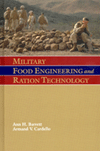
A robotic system that could utilize machine vision to pick a moving object off a conveyor poses an extremely difficult design challenge. When the moving object is a living creature, the challenge of calculating where it will be when the robot tries to grasp it is virtually insurmountable. A different type of grasping system needs to be designed for poultry shackling, and in 1997 Kok-Meng Lee began applying principles of opto-mechatronics, system dynamics and kinematics to devise a compliant grasping mechanism to automate the shackling process. Working with colleagues from the George W. Woodruff School of Mechanical Engineering at the Georgia Institute of Technology in Atlanta and collaborators such as Bruce Wester, a live bird expert with the University of Georgia’s department of poultry science. Lee has devised a system that separates the birds, orients them to a grasping device and then presents the legs in a consistent manner for shackling. Components include a beam-switch and digital camera system and two revolving drums that use a dozen flexible rubber fingers to grasp each bird without injuring it and shackle them at line speeds of 160 to 180 per minute.
A professor at the Woodruff School, Lee has pursued this project with the help of grants from the U.S. Poultry & Egg Association and the Georgia Agriculture Technology Research Program. He holds five U.S. patents, several of which involve spherical motors and methods for orienting and sensing a spherical body. Lee chaired the International Conference on Advanced Intelligent Mechatronics of the Institute of Electrical and Electronics Engineers/American Society of Mechanical Engineers in 1999.
FE: How does the automated shackling process work?
Lee: The birds are conveyed single file in moving pallets that are timed precisely and at a consistent rate toward the dynamic grasper. The birds pass a real-time imaging system that determines their size and orientation on the belt. As they enter the rotating drums of the machine, the flexible fingers grab them and move the body and feet at different velocities. This allows the machine to control the body while the feet are shackled.
FE: Why did you use flexible fingers instead of a multi-joint mechanical grasper?
Lee: Mechanical grasping with a device that emulates the human hand was never attempted because I don’t believe in that approach to automation. It would be like trying to devise a robot that could duplicate the motions of a human washing dishes: it is not going to work.
FE: What is the vision system’s role?
Lee: The presentation of the legs to the shackle depends on the bird’s initial posture, whether it is standing or sitting or facing backward or forward when it enters the grasper. Extensive analysis was necessary to calculate the speeds of the body and legs in relation to the bird’s orientation. The bird’s direction—whether forward or backward—is determined by the position of the red comb with respect to the body. The difficulty is, what do we mean by red? Because the redness will vary from one batch of broilers to the next, we have to pick a few samples and train the system on what we mean by red.
FE: Why does the vision system operate in a blue light environment?
Lee: Based on earlier research on bird vision and capture methods, we knew they do not see blue very well, so they are not even aware of the machine until after the flexible fingers are holding them. The drum rotates at 20 RPMs, or 15 to 20 inches per second, so the bird doesn’t have time to react at all in a low intensity, blue light and is very quiet.
FE: In your earliest tests, birds were conveyed on a level conveyor. Now it declines about 8 degrees. Why was that pitch chosen?
Lee: When we started to address the leg presentation issue, control of the feet became very important. We tried an upward slope, but the bird’s reaction was inconsistent. When we inclined the conveyor downward, the bird’s reaction is very similar to that of a human going down a hill: we let our legs get ahead of us and lean backward a bit. Determining the best pitch to calm the bird was a matter of trial and error, since too severe a slope would cause the bird to panic.
FE: Explain the rotation of the drums with the flexible fingers.
Lee: The drums rotate at the same speed but in opposite directions. Visualize going through a revolving door: it swings in the direction of the wall. I would like the dynamic grasper to be as symmetric as possible, so that the wall becomes the centerline. That way we can ensure equal and opposite force is acting on the bird so that it stays in a centerline.
FE: What were the considerations in designing the fingers?
Lee: You do not know where the finger is going to contact the bird, but you have to try to figure out that point. The stiffness of the finger is also a design challenge, because you need to ascertain the mechanical property of the bird’s meat. We spent a lot of time in tests at the University of Georgia trying to predict what kind of force and stress is occurring within the meat from fingers of varying stiffness. The length of the fingers also has changed as the system has evolved.

Lee: Not with the current design. We could potentially perform the stun before arriving at the unit, but we’d prefer that it occurred once the bird is located and then controlled inside the drum. The whole idea is to keep the bird as calm as possible without killing or bruising it.
FE: What range of bird sizes can be accommodated?
Lee: The pallets and soft rubber fingers are designed to handle birds in the range of 3 to 8 pounds. The basic principles might work for ducks or turkeys, but there would have to be substantial modifications to the drum.
Robotics has never addressed these handling issues before, which is why we have studied poultry shackling in great detail. This lays the groundwork for understanding the handling of many irregular shapes, which is really the situation throughout the food industry. We didn’t want to design a system that simply works for poultry shackling but rather a system that works very well for a variety of live animal-handling situations.
FE: How cost effective is the system?
Lee: We have designed the system to use mechatronic controls as a way to reduce the cost of mechanical structures. Currently there are two motors involved, but eventually we hope to have only one that will control both the body and the feet. Our focus now is on getting the system to work reliably, consistently and at a low cost.
FE: When might this be ready for commercial use?
Lee: We’re working with equipment companies now to facilitate that. We hope to make the system available to one or two firms to integrate with their lines and bring it to the market as soon as possible, hopefully within two years.
One module is 10 to 12 feet long and 3 feet wide. We are very space conscious, and as engineers, we want to make it as compact as possible.
FE: One of your colleagues came under fire from animal-rights extremists. What is their objection?
Lee: We’ve reduced the number of birds we use in experiments in response to complaints, and extensive analytical work precedes any testing with live birds. Unfortunately, some people do not understand current shackling practices. Birds do not respond well to human handling, and they flap around a great deal. Birds don’t perceive machines as a threat, so they tend to be very quiet and calm with an automated system. From a bird welfare standpoint, it’s much better because it minimizes stress. Consequently, it also greatly improves product quality.

